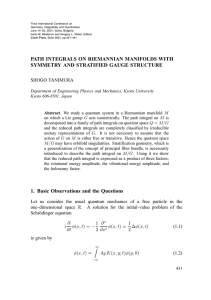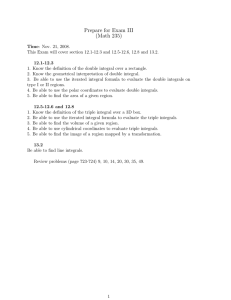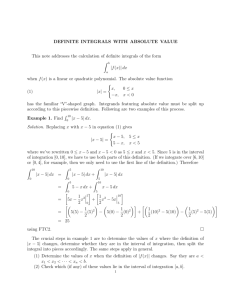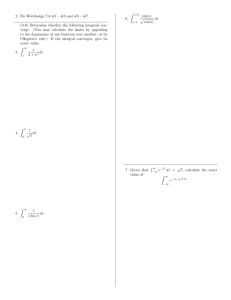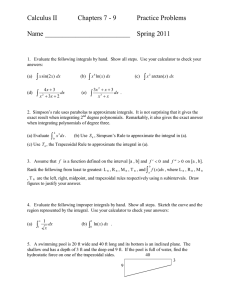Solution of a Nonhomogeneous Heat Equation
advertisement
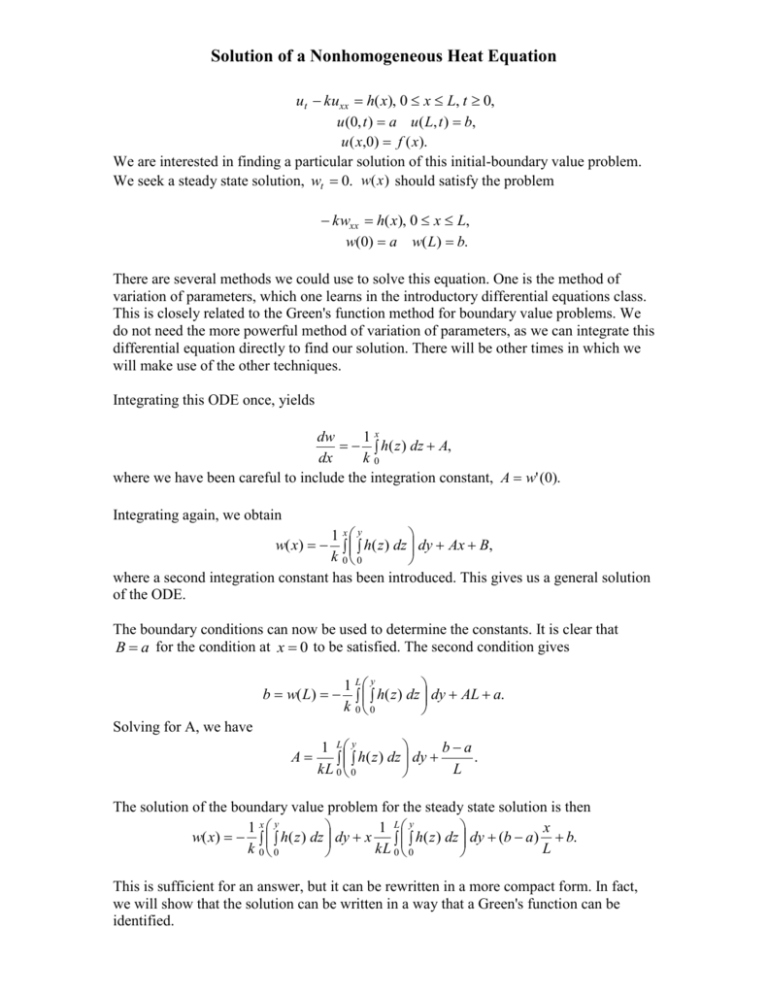
Solution of a Nonhomogeneous Heat Equation ut kuxx h( x), 0 x L, t 0, u (0, t ) a u ( L, t ) b, u ( x,0) f ( x). We are interested in finding a particular solution of this initial-boundary value problem. We seek a steady state solution, wt 0. w(x ) should satisfy the problem kwxx h( x), 0 x L, w(0) a w( L) b. There are several methods we could use to solve this equation. One is the method of variation of parameters, which one learns in the introductory differential equations class. This is closely related to the Green's function method for boundary value problems. We do not need the more powerful method of variation of parameters, as we can integrate this differential equation directly to find our solution. There will be other times in which we will make use of the other techniques. Integrating this ODE once, yields dw 1x h( z ) dz A, dx k0 where we have been careful to include the integration constant, A w' (0). Integrating again, we obtain 1 x y w( x) h( z ) dz dy Ax B, k 0 0 where a second integration constant has been introduced. This gives us a general solution of the ODE. The boundary conditions can now be used to determine the constants. It is clear that B a for the condition at x 0 to be satisfied. The second condition gives b w( L) 1 L y h( z ) dz dy AL a. k 0 0 Solving for A, we have A 1 L y ba . h( z ) dz dy kL 0 0 L The solution of the boundary value problem for the steady state solution is then 1 x y 1 L y x w( x) h( z ) dz dy x h( z ) dz dy (b a) b. k 0 0 kL 0 0 L This is sufficient for an answer, but it can be rewritten in a more compact form. In fact, we will show that the solution can be written in a way that a Green's function can be identified. Solution of a Nonhomogeneous Heat Equation First, we rewrite the double integrals as single integrals. We can do this using integration by parts. Consider integral in the first term of our solution, x y h( z ) dz dy. 0 0 y Setting u h( z ) dz and dv dy in the standard integration by parts formula, we obtain 0 x y y x x x h( z ) dz dy y h( z ) dz 0 yh( y ) dy ( x y )h( y ) dy. 0 0 0 0 0 Thus, the double integral has now collapsed to a single integral. Our solution then takes the form 1x 1 L x w( x) ( x y )h( y )dy x ( L y )h( y ) dy (b a) b. k0 kL 0 L We can make a final simplification if we could combine these integrals. This can be done if the integration range, [0, L] in the second integral is split into two pieces, [0, x] and [ x, L]. Then, rewriting the integrands, 1 x L( x y ) 1 x x( L y ) 1 L x( L y ) x w( x) h( y )dy h( y ) dy h( y ) dy (b a) b. k0 L k0 L kx L L Finally, we combine the first two integrals: 1 x y ( L x) 1 L x( L y ) x w( x) h( y ) dy h( y ) dy (b a) b. k0 L kx L L This solution takes the form L x 1 w( x) G ( x, y ) h( y ) dy (b a ) b, L k 0 where x( L y ) , 0 x y G( x, y) L y ( L x) , yxL L 1 is the Green's function for this problem, . w' ' ( x) h( x). . k The full solution to the original problem can be found by adding a solution of the homogeneous problem: vt kvxx 0, 0 x L, t 0, v(0, t ) 0 v( L, t ) 0, v( x,0) f ( x).

